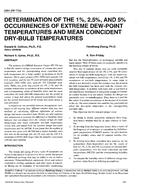Description
The purpose of ASHRAE Research Project RP-754 was to find the outdoor design occurrences of extreme dew-point temperature and the corresponding mean coincident dry-bulb temperature for a large number of locations in North America. Thirty years of data (1961-1990) were used for 239 US locations, and the last 30 years of hourly data available (typically 1960-1989) were used for 143 Canadian locations. Tables are given that present the 1%, 2.5%, and 5% extreme summertime occurrences of dew-point temperatures and corresponding values of humidity ratios and the mean coincident dry-bulb (MCDB) temperature for the period of record. A map that shows the general geographical trends for the spatial distribution of the design dew-point values is also presented. Comparisons are provided between interpolation techniques to fill missing data, different weather data sets, and methods of calculating different definitions of extreme design and mean coincident data. Results are also reported of a comparison to evaluate the difference in humidity ratios between that calculated from the extreme design dry-bulb temperature and mean coincident wet-bulb temperature, versus that calculated from the extreme design dew-point temperature and the MCDB. It was found that the method of extreme dew-point with MCDB had a higher humidity ratio that was on the average (for the 1% case and the 239 US locations) 0.00564lb/lb larger than the humidity ratio found with the other method.
KEYWORDS: year 1995, dew point, temperature, USA, Canada, summer, humidity, ratios, comparing, weather, wet bulb temperature, calculating
Citation: ASHRAE Trans. 1995, Vol.101, Part 2, Paper number 3904 (RP-754), 265-286, figs., tabs., refs.
Product Details
- Published:
- 1995
- File Size:
- 1 file , 2.4 MB
- Product Code(s):
- D-16907




